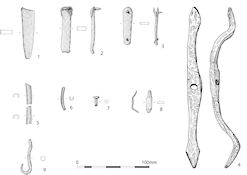
Figure 43: Iron objects from pit 0098.
Metalwork consisted of 88 iron objects of varying preservation and date; weight was unrecorded as the objects are now largely missing. A large proportion of the assemblage (60 fragments, comprising mainly nails) came from the ploughsoil, or contexts of post-medieval or later date. Illustration of objects had clearly being carried out using the radiographs, though these are now no longer available. No copper alloy objects were recovered from the site nor any clear evidence of metalworking.
A single pit (0098) accounted for most of the Iron Age iron objects (Fig. 43), which also included a La Tène III type fibula (0098.1; Fig. 44, no. 1; cf. Hattatt 1989, fig. 149, no. 12) datable to between the 1st century BC and 1st century AD. Other iron objects from this feature were diverse in form and size, and were associated with a range of other artefacts.
From elsewhere on the site there were other datable Iron Age objects, but the majority of these could not be identified with complete certainty, except for another brooch, this one being of La Tène II type and, therefore, datable to the 2nd–1st century BC (Fig. 44, no. 2). A knife (Fig. 45, no. 5; Period 4) with an upward curving blade was an Iron Age type that continued into the Roman period (cf. Manning 1969, type 25).
© Internet Archaeology/Author(s)
URL: http://intarch.ac.uk/journal/issue28/3/4.9.html
Last updated: Wed July 21 2010